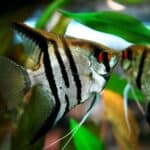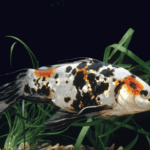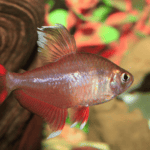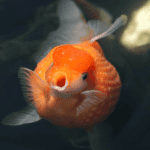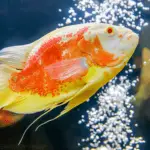The rainbow shark (Epalzeorhynchos frenatus) is a striking and popular freshwater aquarium fish. Its origins trace back to the river basins of Thailand and Indonesia. In this article, we will explore the unique features, care requirements, and breeding practices of this fascinating species.
Appearance and Origin
Also known as the ruby shark, red fin shark, and rainbow shark minnow, the rainbow shark is not a true shark. Instead, it belongs to the minnow family, Cyprinidae. What sets this fish apart is its upright dorsal fin, which gives it a shark-like appearance. The species was first described in 1934 and later moved to its current genus, Epalzeorhynchos, in 1998.
Habitat and Behavior
Rainbow sharks are found near solid surfaces at mid-water and bottom depths in rivers and streams. They also move into seasonally flooded habitats, returning to rivers during the dry season. In captivity, a tank of at least 55 gallons is recommended, with ample plants, décor, and hiding places.
Water conditions should be as follows:
- pH: 6.5-7.5
- Temperature: 75°F – 80°F
- Hardness: 2 to 15 dH
Rainbow sharks are known for their territorial nature, so it is best to stock them singly or with compatible tank mates such as barbs, catfish, large tetras, rainbowfish, danios, loaches, plecos, rasboras, and gouramis. To minimize aggression, they should be kept in groups of at least 5-6 individuals.
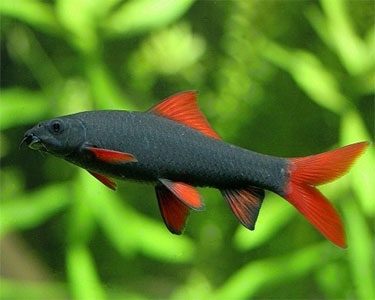
Diet
Rainbow sharks are omnivorous, feeding on algae, periphyton, phytoplankton, and zooplankton in the wild. In captivity, their diet should include:
- Algae tablets, wafers, and flakes
- Live food: insect larvae, tubifex worms, crustaceans, and aquatic insects
- Vegetables: lettuce and spinach
- Frozen food: bloodworms and brine shrimp
Feed them 2-3 times per day.
Health and Common Diseases
Rainbow sharks, like any aquarium fish, can be susceptible to certain health issues. Providing proper care and maintaining water quality are essential for preventing diseases. Some common ailments that can affect rainbow sharks include:
- Ich (White Spot Disease): Caused by the parasite Ichthyophthirius multifiliis, ich presents as small white spots on the fish’s body. To treat ich, increase the water temperature gradually to 86°F for a few days and consider using over-the-counter medications designed for treating ich.
- Fin Rot: This bacterial infection causes the edges of the fins to become discolored and frayed. To prevent fin rot, maintain good water quality and avoid overcrowding. If fin rot occurs, use aquarium salt or antibacterial medications to treat the infection.
- Fungal Infections: Fungal infections can manifest as white, cotton-like growths on the fish’s body. To treat fungal infections, use antifungal medications and improve water quality.
- Internal Parasites: Symptoms include weight loss, loss of appetite, and abnormal feces. Consult a veterinarian or fish expert for advice on treating internal parasites.
Regular water changes and monitoring water parameters can significantly reduce the risk of these diseases.
Tank Setup and Maintenance
A well-designed tank setup is crucial for the health and well-being of rainbow sharks. Here are some key elements to consider:
- Substrate: Opt for a fine gravel or sand substrate, as it closely mimics their natural habitat and reduces the risk of injury.
- Filtration: A high-quality filtration system is essential for maintaining water quality. Choose a filter with both mechanical and biological filtration capabilities.
- Lighting: Moderate lighting is recommended, as it helps promote algae growth, which serves as a food source for rainbow sharks.
- Plants and Décor: Include live plants, rocks, and caves to create hiding places and reduce stress. Driftwood can also be added to create a more natural environment.
Regular tank maintenance, such as weekly water changes of 25-30%, helps maintain water quality and prevent disease.

Growth and Lifespan
Rainbow sharks generally reach a length of 4-6 inches in captivity, with some individuals growing even larger. Providing a balanced diet, proper water conditions, and ample space will support healthy growth.
The average lifespan of a rainbow shark in a well-maintained aquarium is 5-8 years. With optimal care, some individuals may live longer.
Conservation Status and Wild Populations
The conservation status of the rainbow shark is not well-documented, and it does not appear on the IUCN Red List of Threatened Species. However, like many freshwater fish, rainbow sharks may face threats such as habitat loss, pollution, and overfishing for the aquarium trade.
Efforts to protect wild populations could include supporting sustainable fish collection practices, monitoring wild populations, and preserving their natural habitats. As an aquarist, it is essential to purchase fish from reputable suppliers who prioritize sustainability and the well-being of wild populations.
Varieties and Color Morphs
While the standard rainbow shark exhibits a striking coloration with a dark blue or black body and vibrant red or orange fins, there are some known variations within the species. One such variety is the Albino Rainbow Shark, which features a pale yellow or golden body with red or pink fins. These color morphs are a result of genetic mutations and are selectively bred in the aquarium trade for their unique appearance.
Although care requirements for color morphs are generally the same as for the standard rainbow shark, it is essential to monitor them closely for signs of stress or health issues, as some varieties may be more susceptible to specific ailments or have different sensitivity levels to light.
Tips for Reducing Aggression
Rainbow sharks are known for their territorial behavior, which can lead to aggression towards tank mates. To minimize aggression and maintain a peaceful aquarium environment, consider the following tips:
- Provide Plenty of Hiding Spaces: Include caves, rocks, and plants to create multiple hiding spots and territories within the tank. This will reduce competition for space and allow the rainbow shark to establish its own territory.
- Choose Compatible Tank Mates: Select fish species that can coexist peacefully with rainbow sharks, such as larger tetras, barbs, danios, loaches, and gouramis. Avoid keeping rainbow sharks with other similar species, such as red tail sharks.
- Maintain a Spacious Tank: A larger tank size (55 gallons or more) will provide ample swimming space for rainbow sharks and their tank mates, reducing the likelihood of territorial disputes.
- Group Dynamics: Keeping rainbow sharks in groups of at least 5-6 individuals can help disperse aggression, ensuring no single fish becomes a target.
- Monitor Behavior: Regularly observe your aquarium to identify signs of aggression early and take appropriate action, such as rearranging the tank or removing overly aggressive individuals.
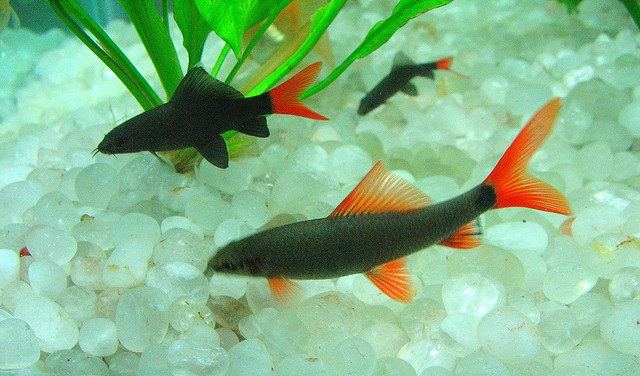
Aquascaping for Rainbow Sharks
Creating an aquascape that caters to the specific needs and preferences of rainbow sharks can contribute to their overall health and well-being. Here are some tips for designing a suitable environment:
- Substrate: Use a fine gravel or sandy substrate to mimic their natural riverbed habitat and reduce the risk of injury.
- Plants: Incorporate live plants, such as Java fern, Anubias, and Vallisneria, which can tolerate the moderate lighting and water conditions preferred by rainbow sharks.
- Rocks and Caves: Add rock formations, caves, and overhangs to create hiding spots and territorial boundaries for the rainbow shark.
- Driftwood: Include pieces of driftwood to create a more natural environment and additional hiding places.
- Swimming Space: Ensure there is ample open swimming space for rainbow sharks to navigate, especially in the middle and bottom areas of the tank.
By designing an aquascape that meets the needs of rainbow sharks, you can provide them with a comfortable and visually appealing environment in which they can thrive.
Breeding
Breeding rainbow sharks in captivity can be challenging due to their aggression towards their own species. Hormone injections are often used to facilitate spawning. Both males and females should be at least 4 inches long before attempting breeding.
To breed rainbow sharks, follow these steps:
- Provide a 75-gallon or larger tank.
- Feed protein-rich food like brine shrimp or tuna.
- Change 25% of the water in the tank.
- Wait for the female to lay eggs on the aquarium gravel, then the male will fertilize them.
- After hatching, transfer the fry to a 10-gallon tank with dechlorinated water and a mini heater.
- Feed liquid fry food for 1-2 weeks, then introduce baby brine shrimp.
- Move the fingerlings to their own tanks when they reach 1/2 to 1 inch long.
Juveniles need a lot of vegetation in their diet for proper growth and coloration. Without proper nutrition, their colors may fade, and growth may be stunted.
Sexing
Sexing rainbow sharks is difficult at the juvenile stage. However, sexually mature females tend to have thicker bodies than males, while males are slimmer and have black lines on their anal fins.
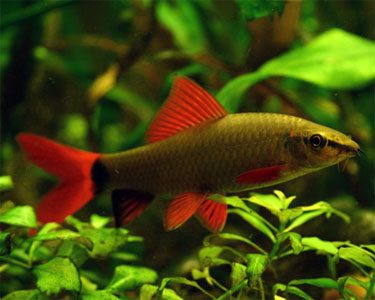
Conclusion
The rainbow shark is a captivating freshwater aquarium fish that offers a unique appearance and intriguing behavior. Proper care, a well-balanced diet, and thoughtful tank mate choices can help ensure a thriving environment for these beautiful creatures.
Rainbow Shark FAQ
Q: How big do rainbow sharks get?
A: Rainbow sharks typically grow to a length of 4-6 inches in captivity, with some individuals growing even larger.
Q: What is the lifespan of a rainbow shark?
A: The average lifespan of a rainbow shark in a well-maintained aquarium is 5-8 years, although some individuals may live longer with optimal care.
Q: What tank size is suitable for a rainbow shark?
A: A minimum tank size of 55 gallons is recommended for a single rainbow shark. Larger tanks are preferred, especially if the shark is kept with other fish.
Q: Can rainbow sharks be kept with other fish?
A: Yes, rainbow sharks can be kept with compatible tank mates such as larger tetras, barbs, danios, loaches, and gouramis. However, avoid keeping them with other similar species like red tail sharks.
Q: How can I reduce aggression in my rainbow shark?
A: To reduce aggression, provide ample hiding spaces, maintain a spacious tank, choose compatible tank mates, keep them in groups of at least 5-6 individuals, and monitor their behavior regularly.
Q: What do rainbow sharks eat?
A: Rainbow sharks are omnivorous and primarily consume algae in captivity. They can be fed algae tablets, wafers, and flakes, as well as live foods such as insect larvae, tubifex worms, and brine shrimp. Supplement their diet with vegetables like lettuce and spinach.
Q: How can I tell the difference between male and female rainbow sharks?
A: Sexually mature females have a noticeably thicker body than males. Males are slimmer and have black lines on their anal fin.
Q: Can I breed rainbow sharks in captivity?
A: Breeding rainbow sharks in captivity can be challenging due to their aggression towards their own species. However, hormone injections can be used to induce breeding, and a 75-gallon or larger tank is required for spawning.
Q: How do I set up the ideal tank environment for my rainbow shark?
A: To create a suitable tank environment, use a fine gravel or sand substrate, provide ample hiding places with rocks, caves, and live plants, ensure moderate lighting, and install a high-quality filtration system to maintain water quality.
Q: Are there any color variations of the rainbow shark?
A: Yes, there are color variations, such as the Albino Rainbow Shark, which has a pale yellow or golden body with red or pink fins. These color morphs are a result of genetic mutations and are selectively bred in the aquarium trade.
Q: How often should I feed my rainbow shark?
A: Feed your rainbow shark 2-3 times per day, offering a mix of algae-based foods, live foods, and vegetables to provide a balanced diet.
Q: How do I treat common diseases in rainbow sharks?
A: Treatment depends on the specific ailment. For ich, raise the water temperature to 86°F and use over-the-counter medications. For fin rot, use aquarium salt or antibacterial medications. For fungal infections, use antifungal medications and improve water quality.
Q: How can I support the conservation of wild rainbow shark populations?
A: To help protect wild rainbow shark populations, purchase fish from reputable suppliers who prioritize sustainability, support efforts to preserve their natural habitats, and stay informed about the species’ conservation status.

